The Beast is tamed…
Ducati Panigale V4 S review by Adam Child
In MotoGP, if you didn’t have wings last season you were on the outer and Ducati’s ‘winged’ Panigale V4 R dominated the British Superbike series last year and in World Superbike Ducati looked unstoppable, at one stage… Downforce-generating wings are now everywhere in motorcycle racing and now the technology is filtering down to the end-user on the road, which is great news for me and you. And yeah, they look pretty cool.
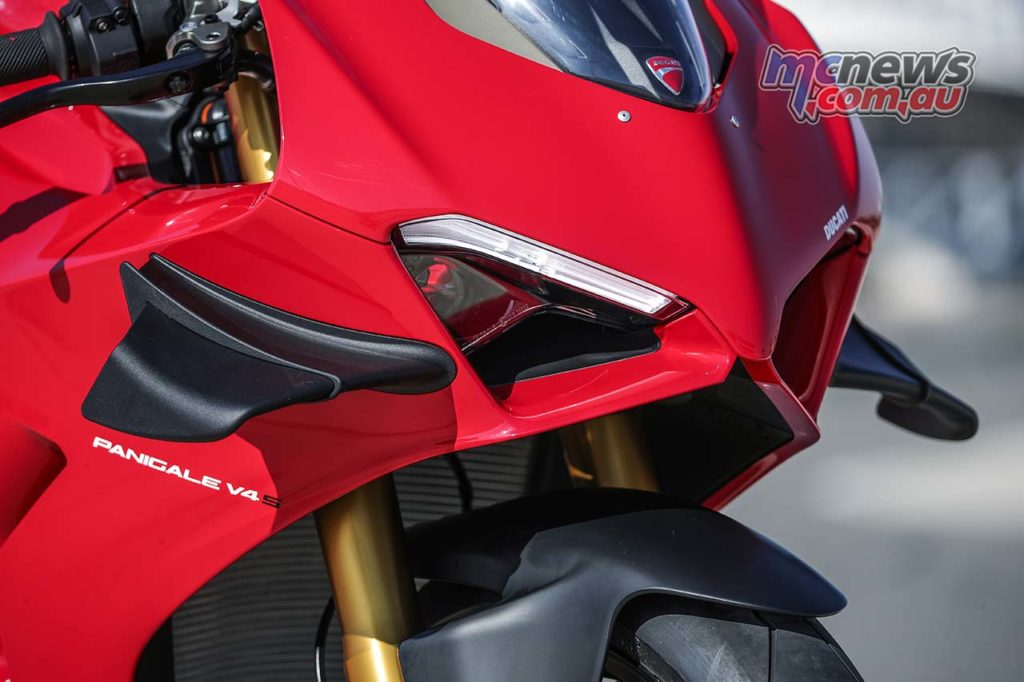
For 2020 Ducati has added its distinctive wings to the Panigale V4 S along with other improvements such as updated Evo 2 electronics, revised handling, and easier-to-use power characteristics with lower torque in the first three gears.
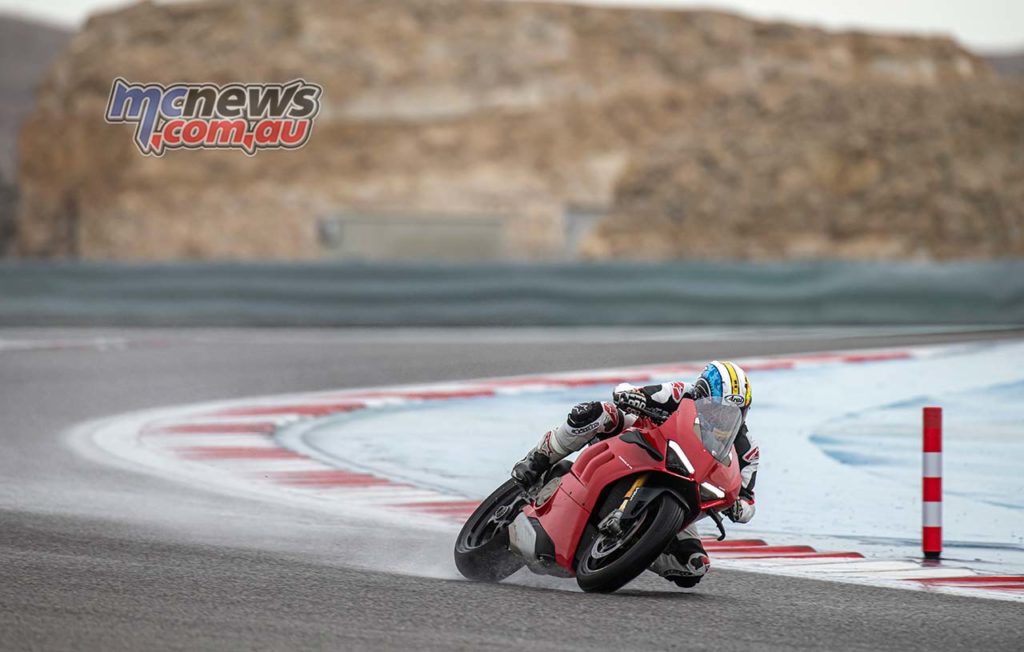
We sent international journalist, and former road racer, Adam Child, to Bahrain to test out the new $40,490, V4 S around the very fast 5.4 km F1 track. And yes, it rained, in the desert, where it never rains. But luckily the Brit is use to racing the rain, and if Ducati are claiming their new V4 S is easier to ride, then what better way to find out than in the wet at 180 mph?
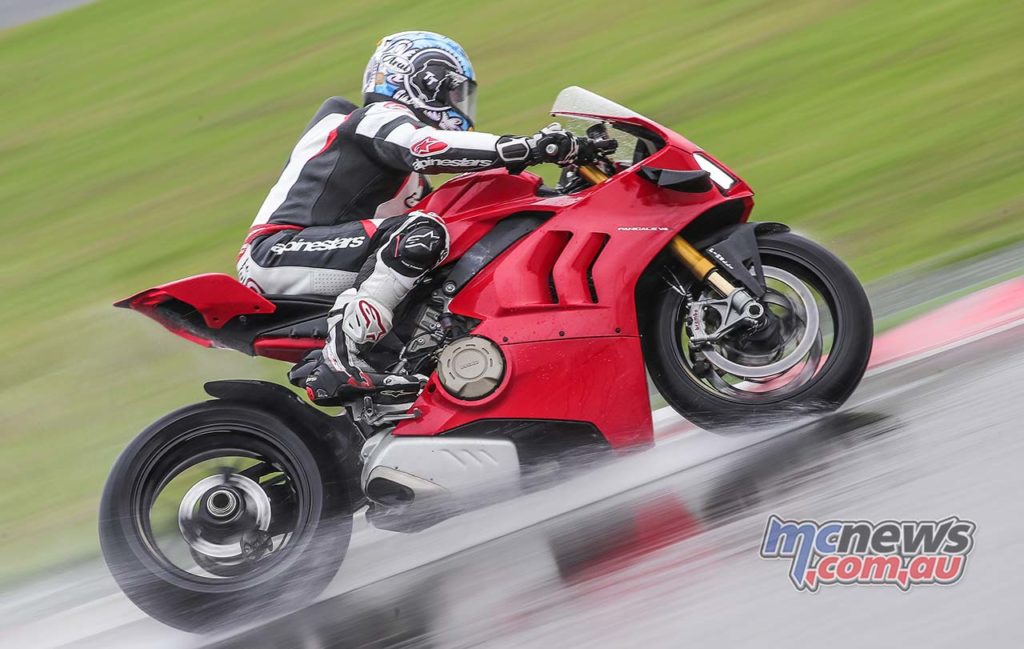
The 2020 V4S’s new wings are the same shape and dimensions as those seen on the WSBK and British Superbike machines that were so dominant last year. Aside from looking good and instantly shouting ‘I’ve bought a new Ducati’, they exist to create downforce and are now standard fitment.
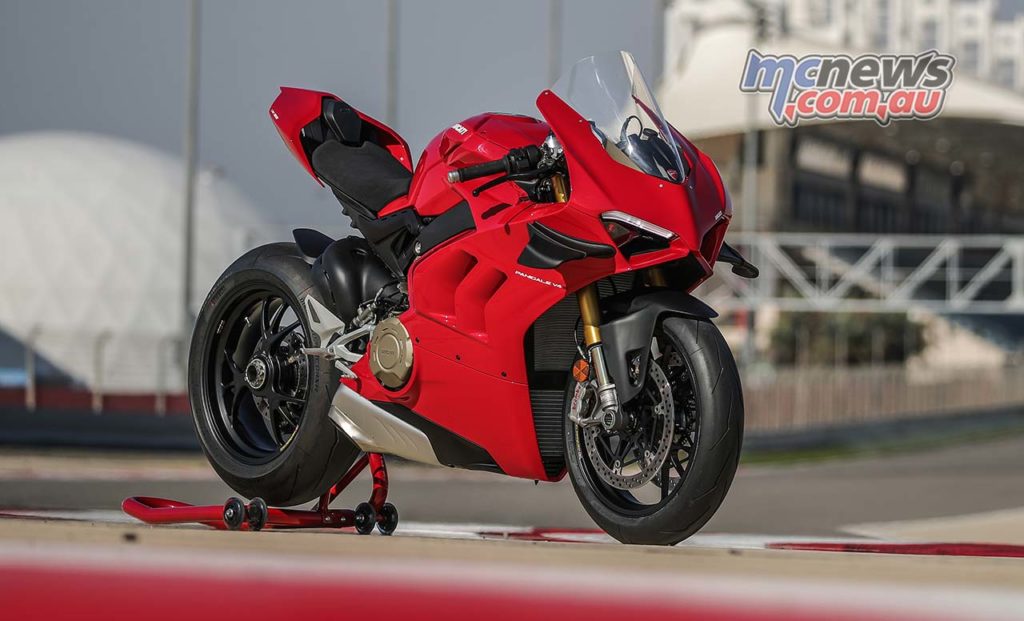
Like an aeroplane wing (in reverse) they only make a difference at high speed. At 100 km/h they create 4 kg of downforce; at 200 km/h, 16 kg; and at 300 km/h, 37kg. This downforce has numerous benefits, chief among them a reduction in power wheelies as all that weight is pushed down onto the front end, meaning less electronic intervention by traction control and, for the rider, less rolling off of the throttle.
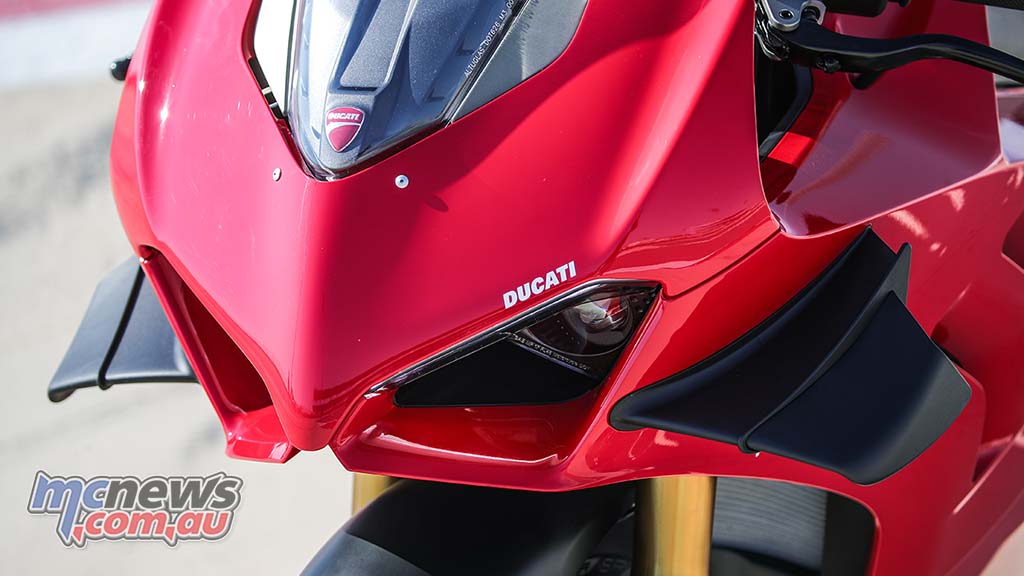
Often at high speeds, a conventional front end can get flighty as the rushing airflow lifts the front, and the rider, holding on for dear life, accentuates the effect by pulling on the bars. As speed raises, the forks extend and in extreme situations the shock sits. But wings add downforce, forcing more weight onto the front wheel contact patch, giving a more planted feeling while allowing the bike to steer better and hold a tighter line.
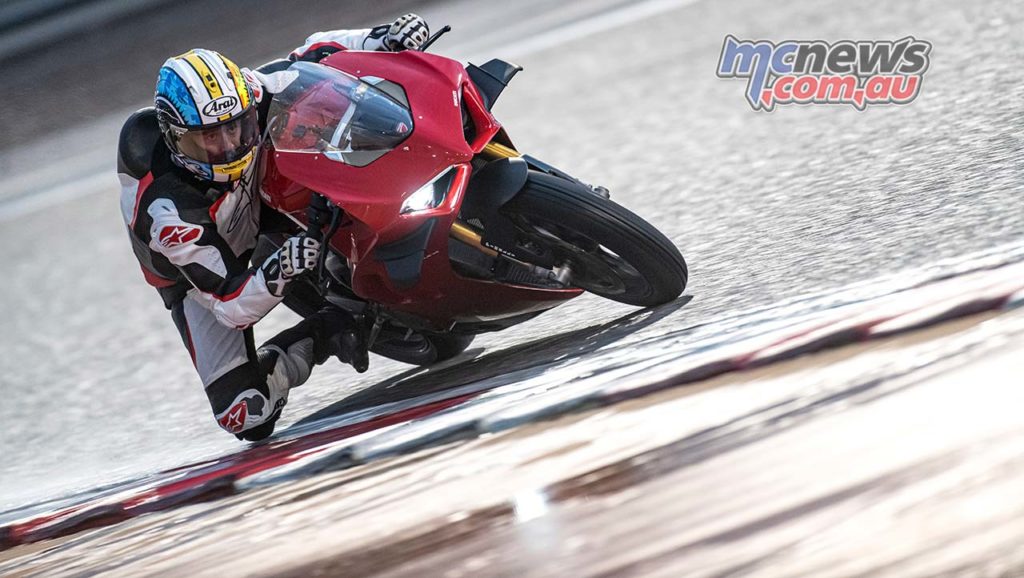
At Bahrain’s 5.4 km F1 race track, the wings were inspiring, while stability, even in the wet nudging 300 km/h, was excellent. There was a minor weave from the bars, but this was due more to the movement of the wet tyre at speed than aero. In 160 km/h-plus, third-gear corners the Ducati held its line impeccably, understeer lacking as the front tyre was squashed into the track.
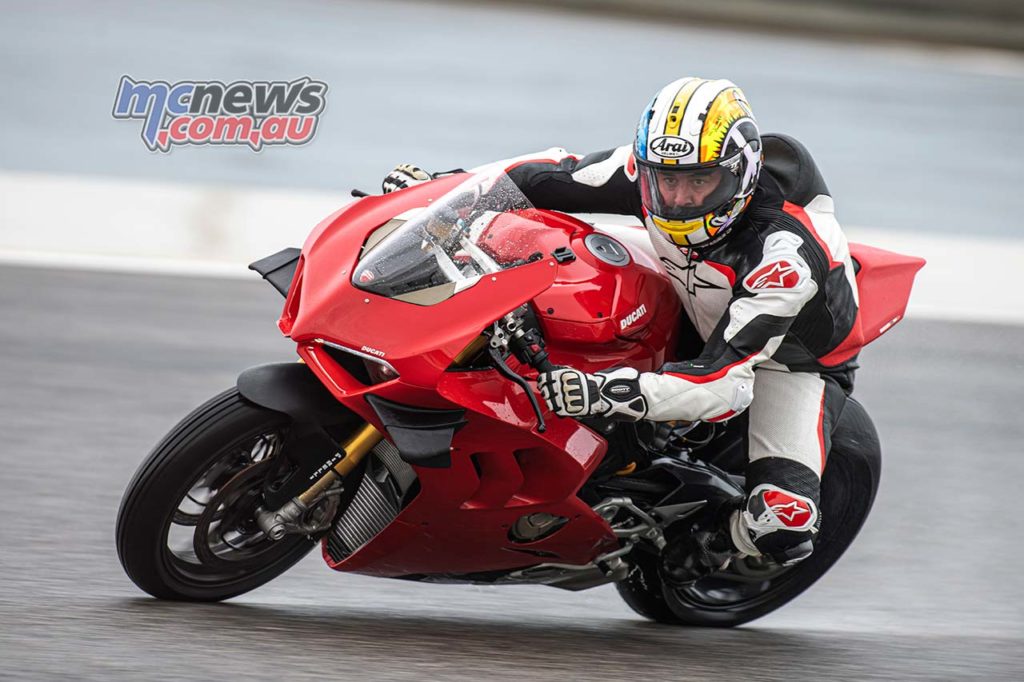
The only downside to aerodynamic downforce is that they create drag, which reduces top speed and will increase fuel consumption. However, Ducati has re-thought the bodywork for 2020, making the bike more aerodynamic to offset this, meaning top speed hasn’t been significantly affected. And hey if you’re worried about fuel economy, then perhaps don’t buy a Ducati Superbike.
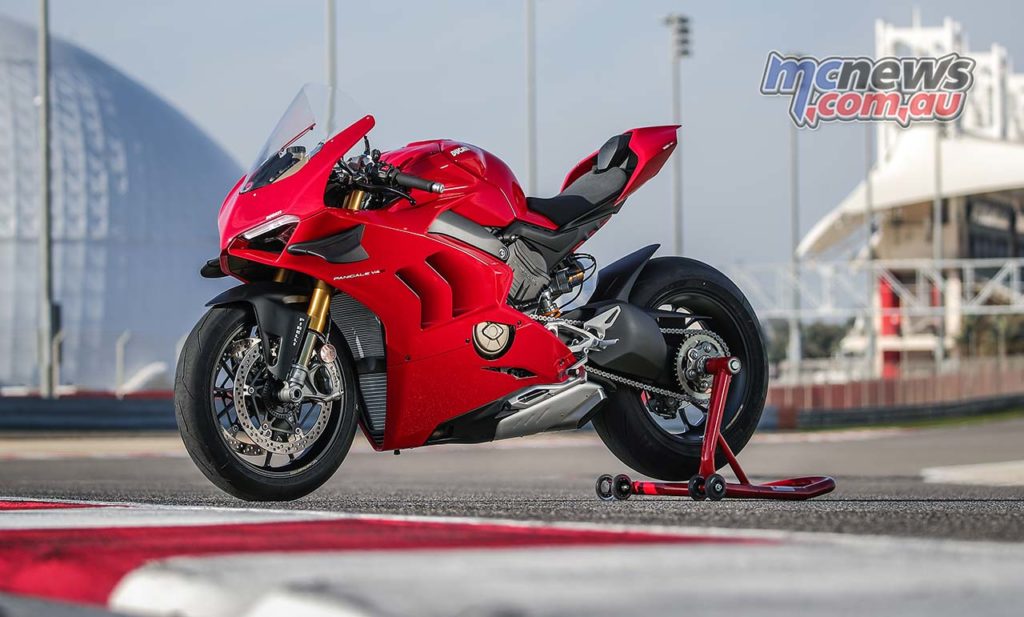
The front fairing is 15 mm wider per side, the screen 34 mm taller and the sides extend outwards 38 mm more than before. The larger fairing gives the rider an easier time; you can tuck out of the wind. And again, the added bodywork aids the stability as the rider, now cocooned behind a larger screen, isn’t holding on as hard and pulling on the bars as they fight the wind-blast.
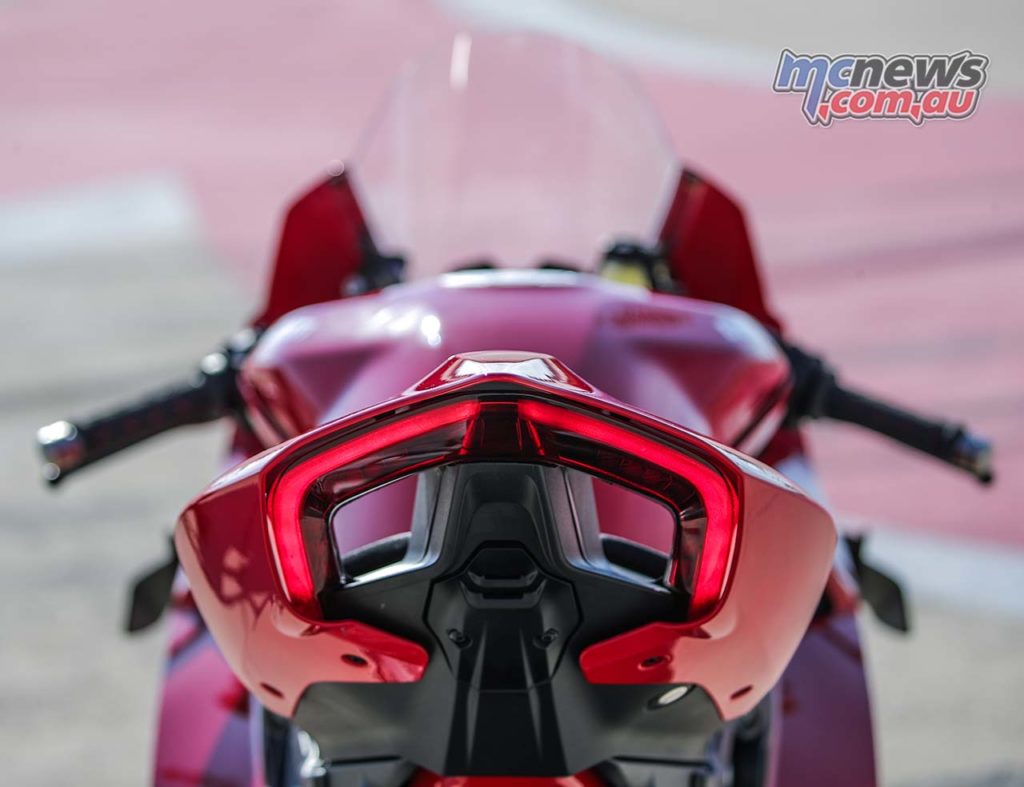
Ducati has even improved the air-flow around the bike, which should mean the Panigale might now be cooler in traffic, the now old bike did it’s best to BBQ your inner legs in summer.
Despite the V4S’s huge output, wheelies were never a problem on track in Bahrain, albeit on what is a super-flat F1 surface – though some of this progress could be down to the new V4’s reduced torque and superior electronic riding aids. Ducati has reduced the Desmosedici’s Stradale’s arm-ripping torque in the first three gears to make the bike more rideable before full torque is unleashed in the higher gears.
The four-cylinder Panigale is still rapid – the 1103 cc 90° V4’s peak power remains at 214 hp – but by allowing the rider to get on the power more smoothly and safely in those lower gears, it is markedly easier to use. This doesn’t mean slower – you can get on the power sooner, and without traction control intervention it ultimately means your top speed is higher on the straight and your lap-time is reduced with less effort from the rider.
Ducati have developed the front alloy frame from the V4 R WSBK bike, which reduces torsional and braking stiffness. Optimising chassis stiffness is like wearing race gloves, rather than over gloves: you have more feel, there is a closer connection between the front tyre and the rider. The damp conditions during our test amplified this, you could feel the accessible grip through the front Pirelli. Some sections of the F1 track had marginally more grip than others, a fact translated to my brain by subtle but distinct signals.
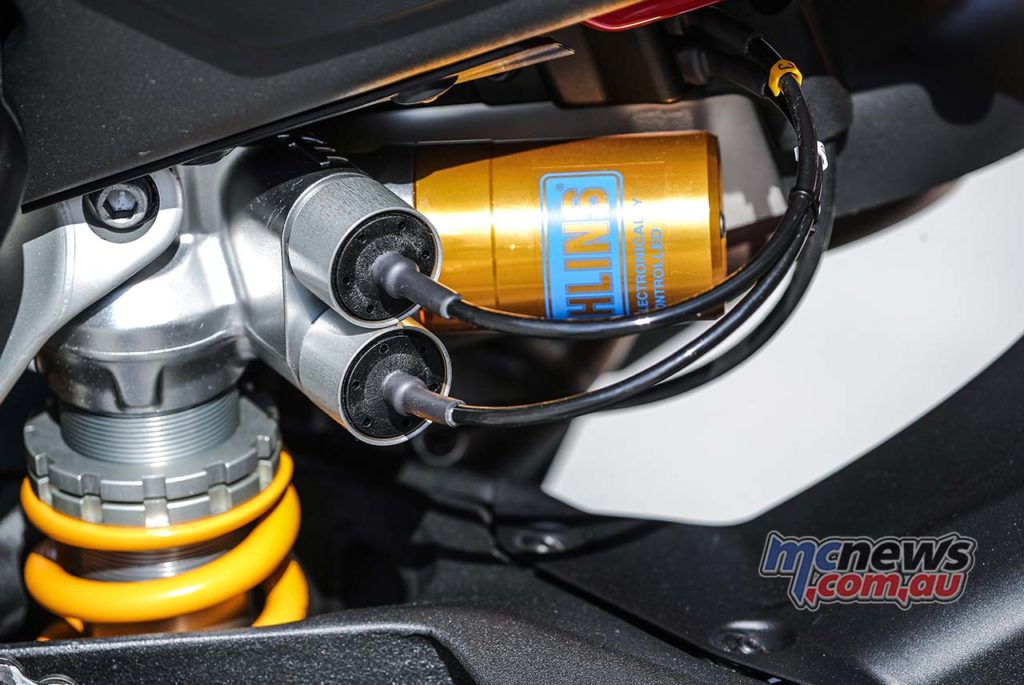
Although the suspension seems visually the same as before, it’s very different. The bike’s centre of gravity has been raised 5 mm by raising the front by 4 mm while the rear shock is 2 mm longer with a 5 mm longer shock linkage. The rear spring rate is lower and pre-load is set higher.
Lifting a bike and raising the centre of gravity allows it to turn easier, like how tall people fall over easier than short people when drunk. The plusher rear adds grip and feel in the same way the chassis, mentioned above, has improved the front-end feel.
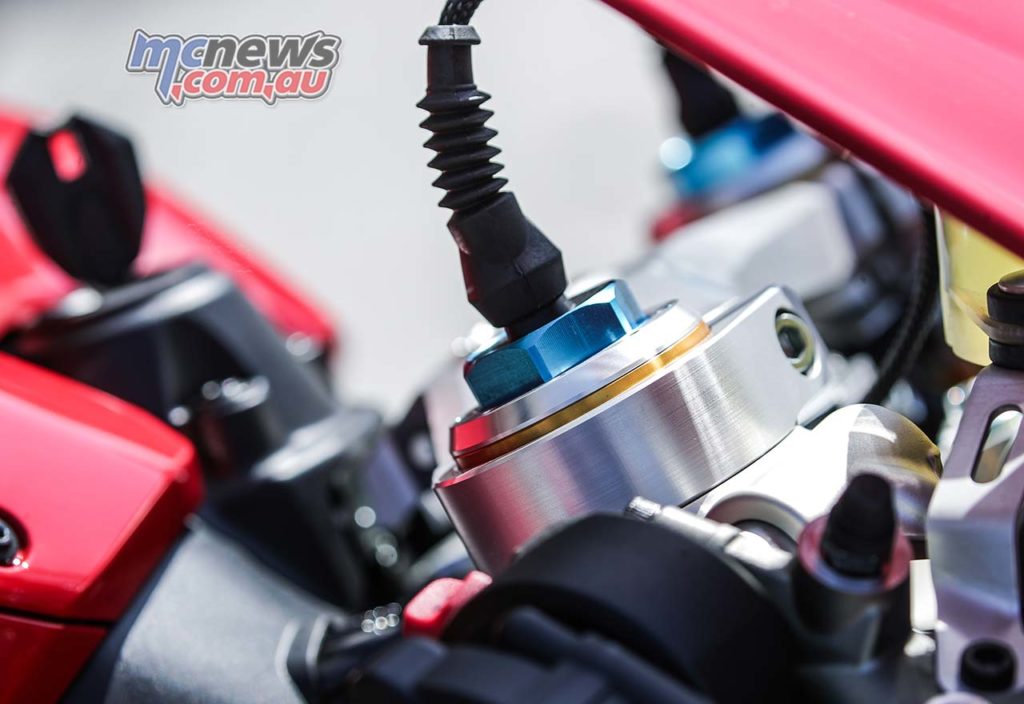
The disadvantage of raising the C of G is that it tends to reduce the tyres’ edge grip at high angles of lean. To offset this Ducati has softened the rear suspension to aid grip and feel. The rear shock is a little softer and has more ride height, which has subsequently raised the seat height my 5 mm.
The bike undoubtedly turns with ease, and again wet conditions highlighted the improvements in front-end feel. You can feel the front tyre squirming and discovering grip, both on and off the brakes. The cornering ABS isn’t too intrusive and allows you to manipulate and feel that grip. Those Brembo radial M4.30 brakes are outstanding, the ABS EVO cornering system developed in partnership with Bosch is almost mind-blowingly effective. End of the straight, just shy of 185 mph, in torrential rain, and it’s time to jump on the stoppers for turn one – a first gear crawl of around 40 mph. The only bit we couldn’t test was edge grip at extreme lean. In the wet I wasn’t that brave. We will have to wait for a dry track day back home.
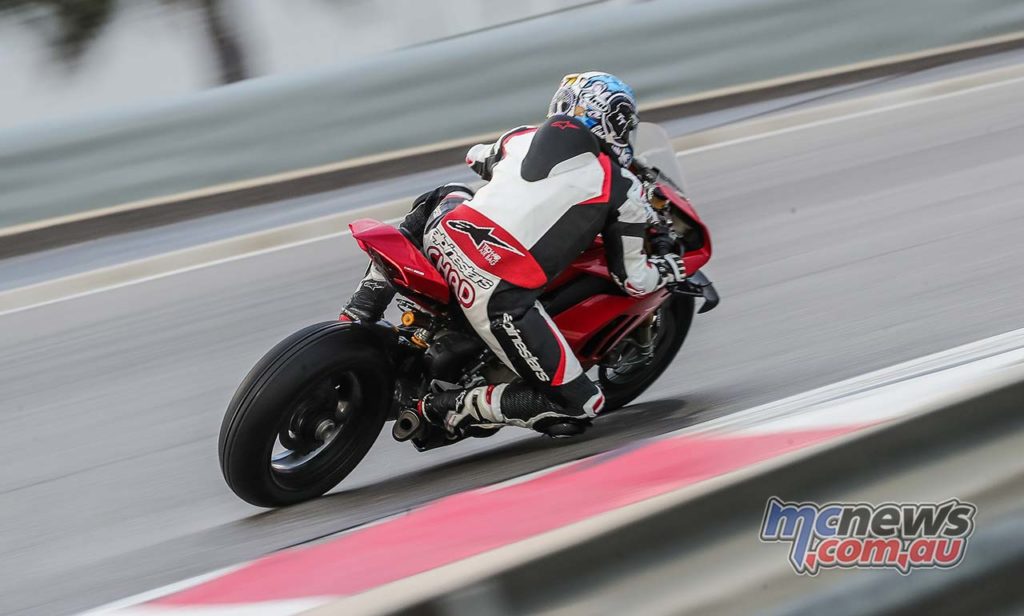
For any rider to be fast they must have confidence in their bike, know where the limit is, and understand the feeling and level of grip from the tyres – and Ducati has significantly improved this feeling with the new V4S, the test’s wet conditions a great proving ground.
This isn’t just a bike for former racers anymore, a lightweight 214 hp superbike shouldn’t be so forgiving and, dare I say, so easy to ride in the wet. In back-to-back testing with the now old model, Ducati found that ultra-quick test rider, Michele Pirro, was 0.4s quicker on the new bike, while a more average fast track rider was over a second faster, highlighting how much easier the new bike is to ride.
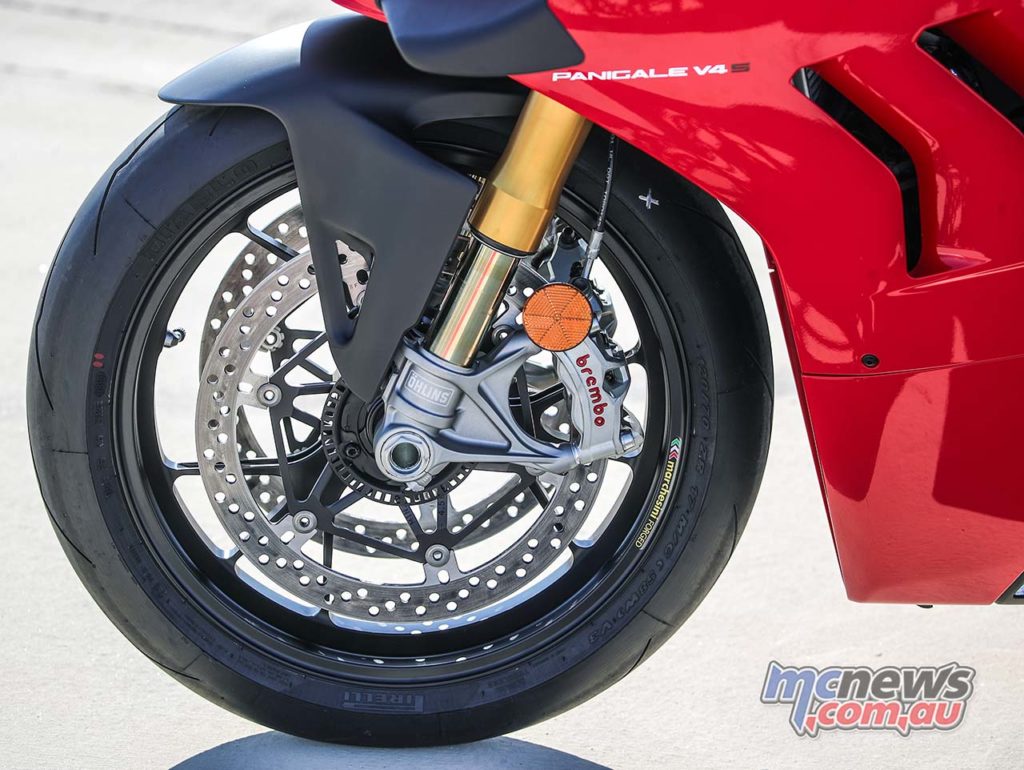
Some features of the bike have remained untouched. Ducati has kept the same engine spec’ and lay-out. The massive Brembo monobloc brakes remain, as does the cast aluminium single-sided swingarm. Other items carried over include the Marchesini aluminium wheels, magnesium head-lamp and mirror support and cast aluminium sub-frame. Pirelli Diablo Supercorsa SP rubber comes as standard with a 200/60 section rear but during our test we ran full race wets.
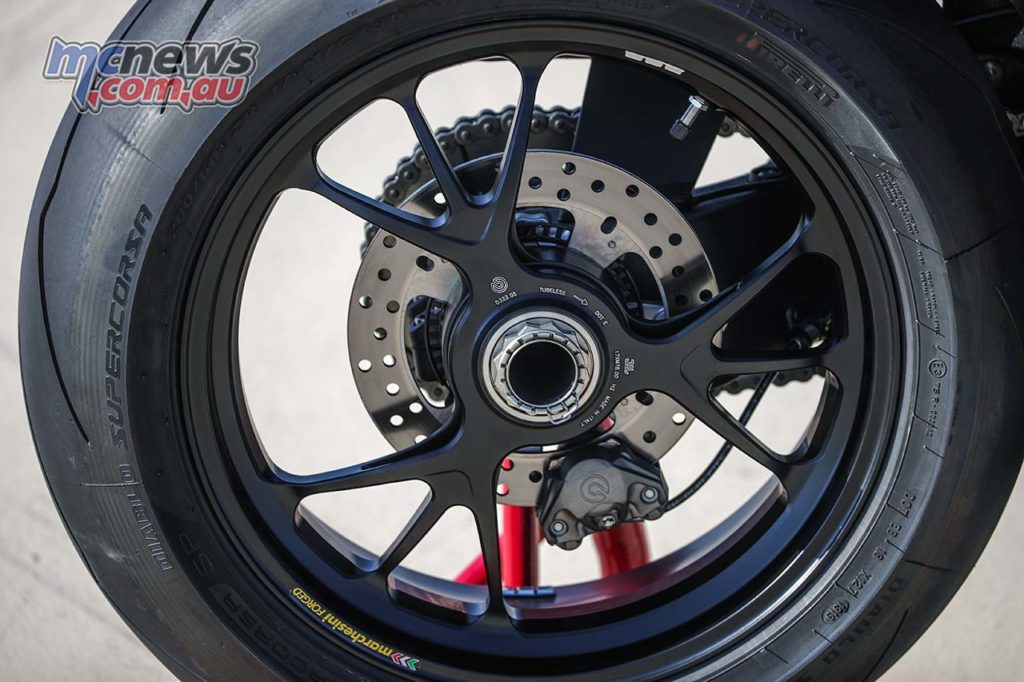
The new EVO 2 system, which is similar to that used on the R model, is faster and smoother than before. Again, in the damp, you can feel the TC working overtime, but it’s only allowing a fraction less power than you’re asking for to control the slide and spin. In one very wet session it even coped with standing water without too many complaints. And remember, these rider aids can be changed on the move, via the three rider modes: race, sport, and street. Each mode adjusts the power, traction, wheelie and slide control, plus the cornering ABS, engine braking and even damping. With a closed throttle, change the mode, and simply switch over via the toggle on the left bar. It’s not confusing, just straight-forward to use.
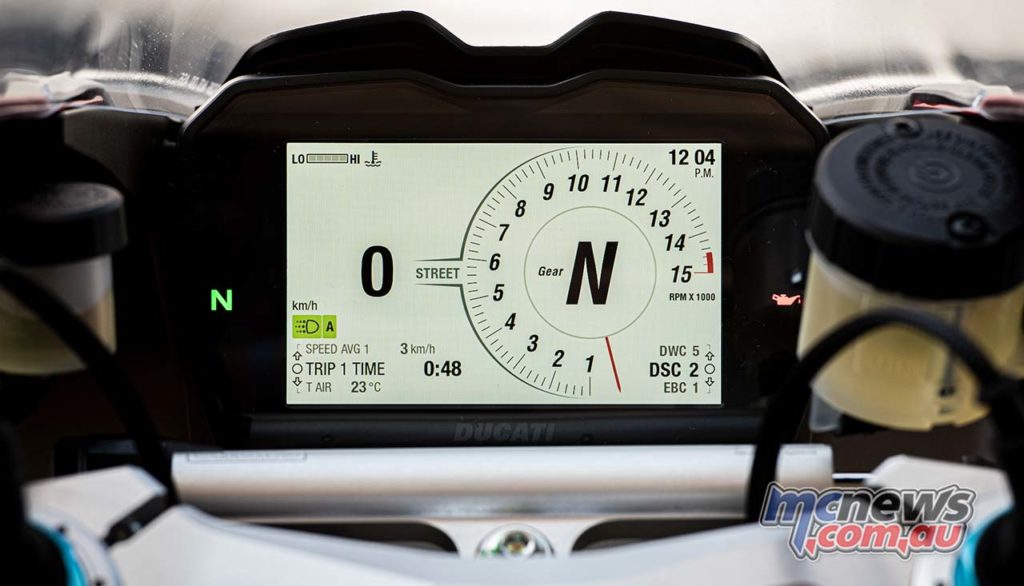
In one session, as the track and grip improved, I changed the pre-set modes, which increased the stiffness in the rear to increase high-speed stability (race wet tyres move around at high speed), and reduced the rider aids a fraction. I immediately noticed the difference these incremental changes made, again highlighting how much feedback the stunning new Ducati V4S gives.
Verdict
Yes, it was wet, more like the UK than Bahrain, and I would have preferred the dry, but in many ways it was a better to test Ducati’s claims of an easier, more forgiving bike for 2020.
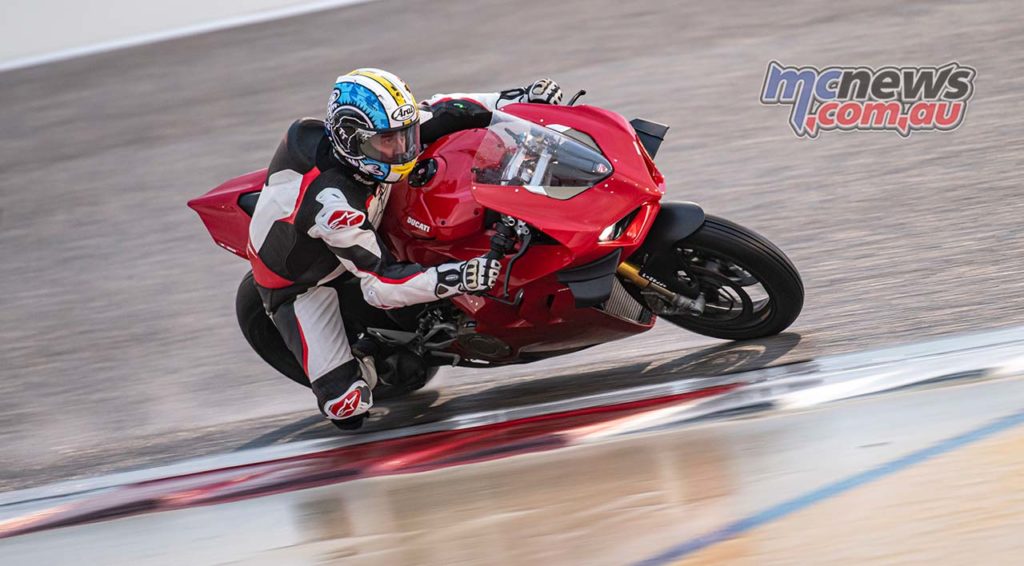
After riding all day in mixed conditions until dark I can confirm the 2020 V4S is more forgiving. I can certainly see a less experienced rider lapping quicker on the new bike, as Ducati found during their testing. You can ride faster and for longer as it’s easier.
Simply put, the beast has been tamed. It’s now far easier to ride, especially for less experienced riders. 214 horsepower has never been so simple to manage, and the wet test amplified this.
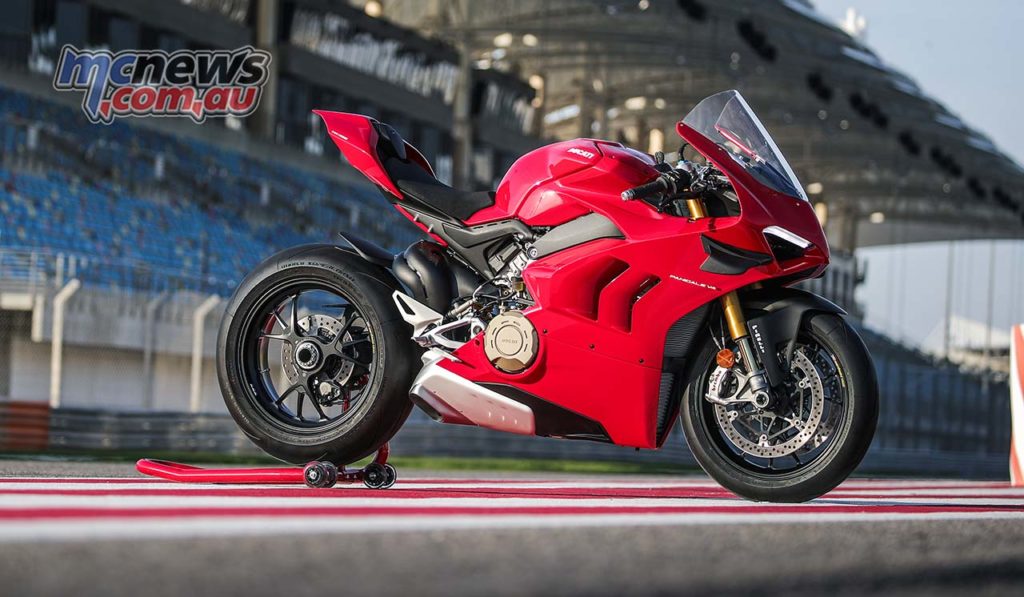
It has arguably the best electronics package on any bike on the market and is also perhaps the most desirable and sexy sportsbike on sale too.
It is expensive and friends will be envious, so it’s not perfect, but close. And you will have to wait until least April to get your hands on one in Australia.
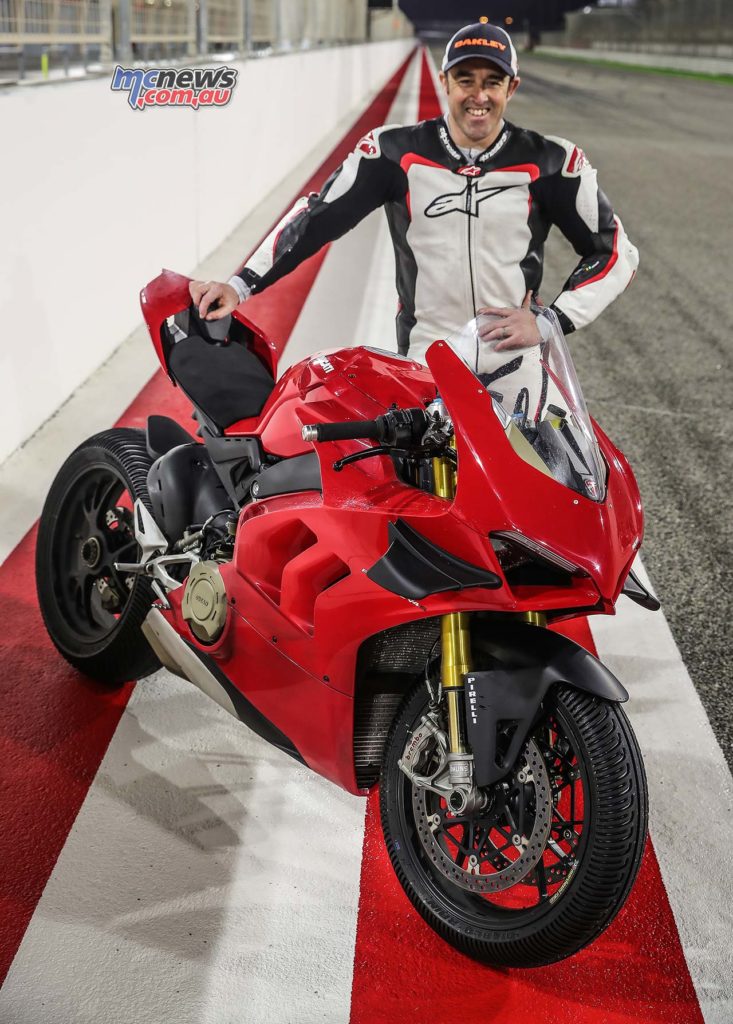
2020 Ducati Panigale V4 Specifications
| Panigale V4 S | |
| Engine & Drivetrain | |
| Engine: | Desmosedici Stradale 90° V4, counter-rotating crankshaft, 4 Desmodromic timing, 4 valves per cylinder, liquid-cooled |
| Displacement: | 1,103 cc |
| Bore x Stroke: | 81 mm x 53.5 mm |
| Compression ratio: | 14.0:1 |
| Power: | 214 hp (157.5 kW) |
| Torque: | 91.5 lb-ft (124.0 Nm) |
| Fuel injection: | Electronic fuel injection system. Twin injectors per cylinder. Full ride-by-wire elliptical throttle bodies. Variable length intake system |
| Exhaust: | 4-2-1-2 system, with 2 catalytic converters and 2 lambda probes |
| Transmission: | 6 speed with Ducati Quick Shift (DQS) up/down EVO 2 |
| Primary drive: | Straight cut gears; Ratio 1.80:1 |
| Ratio: | 1: 38/14, 2: 36/17, 3: 33/19, 4: 32/21, 5: 30/22, 6: 30/24 |
| Final drive: | Chain; Front sprocket 16; Rear sprocket 41 |
| Clutch: | Hydraulically controlled slipper and self-servo wet multiplate clutch |
| Chassis | |
| Frame: | Aluminum alloy “Front Frame” with optimized stiffnesses |
| Front suspension: | Öhlins NIX30 43 mm fully adjustable fork with TiN treatment. Electronic compression and rebound dampening adjustment with Smart EC 2.0 event-based mode |
| Rear Suspension: | Fully adjustable Öhlins TTX36 unit. Electronic compression and rebound damping adjustment with Öhlins Smart EC 2.0 event-mode. Aluminum single-sided swingarm |
| Rake: | 24.5° |
| Front wheel trail: | 3.94 in (100 mm) |
| Front brake: | Dual 330 mm semi-floating discs, radially mounted Brembo Monobloc Stylema® (M4.30) 4-piston calipers with Bosch Cornering ABS |
| Rear brake: | 245 mm disc, 2-piston caliper with Cornering ABS EVO |
| Front wheel: | 3-spokes forged aluminum alloy 3.50” x 17” |
| Rear Wheel: | 5-spokes forged aluminum alloy 6.00” x 17” |
| Front tire: | Pirelli Diablo Supercorsa SP 120/70 ZR17 |
| Rear tire: | Pirelli Diablo Supercorsa SP 200/60 ZR17 |
| Wheel travel (front/rear): | 4.7 in (120 mm) / 5.1 in (130 mm) |
| Dimensions & Capacities | |
| Dry weight: | 384 lb (174 kg) |
| Curb weight: | 430 lb (195 kg) |
| Seat height: | 32.9 in (835 mm) |
| Wheelbase: | 57.8 in (1,469 mm) |
| Fuel tank capacity: | 4.23 gallon (16 l) |
| Number of seats: | Dual seats |
| Top Speed: | 300 km/h (est) |
| Details | |
| Instrumentation: | Latest generation digital unit with 5” TFT color display |
| Safety equipment: | Riding Modes, Power Modes, Cornering ABS EVO, Ducati Traction Control (DTC) EVO 2, Ducati Wheelie Control (DWC) EVO, Ducati Slide Control (DSC), Engine Brake Control (EBC) EVO, Auto tire calibration |
| Standard equipment: | Ducati Power Launch (DPL), Ducati Quick Shift (DQS) up/down EVO 2, Full LED lighting with Daytime Running Light (DRL), Ducati Electronic Suspension (DES) EVO with Ohlins suspension and steering damper, Quick adjustment buttons, Lithium-ion battery, Auto-off indicators, Marchesini aluminium forged wheels, Racing style handle grips |
| Additional equipment: | Passenger seat and footpegs kit |
| Ready for: | Ducati Data Analyser (DDA+) with GPS module, Ducati Multimedia System (DMS) and anti-theft |
| Emissions: | Euro 4 |
| Fuel Economy: | 6.9 litres/100km |
| Color: | Ducati Red |
| RRP: | $40,490 Ride Away |
Ducati Safety Pack
The new Ducati V4S gets the DTC EVO-2 electronics package derived from MotoGP and WSBK and already deployed on Ducati’s premium V4R. All parameters, like throttle position, are in constant communication with the six-axes IMU, which measures lean angle plus pitch and yaw. The list of rider aids is jaw-dropping: cornering ABS, traction control, slide control, wheelie control, launch control, engine brake strategy, a new quicker up-and-down quickshifter and electronic Öhlins suspension. Everything is navigated by the menu button the left bar and can be changed on the move with a closed throttle. There are three rider modes: race, sport and street. Each mode changes the power, traction, wheelie and slide control, plus the cornering ABS, engine braking and even damping. If you’re very brave you can turn off the traction, wheelie and slide control, and just have ABS on the front only. You can even have manual damping control, rather than the pre-set suspension modes.
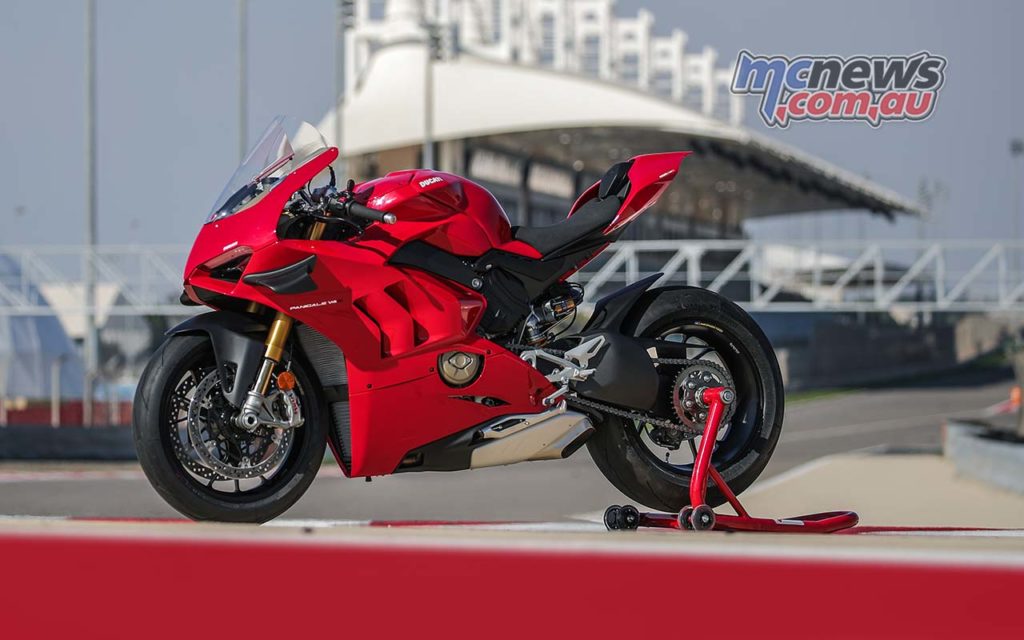
Images by Milagro
| Panigale V4 | |
| Engine & Drivetrain | |
| Engine: | Desmosedici Stradale 90° V4, counter-rotating crankshaft, 4 Desmodromic timing, 4 valves per cylinder, liquid-cooled |
| Displacement: | 1,103 cc |
| Bore x Stroke: | 81 mm x 53.5 mm |
| Compression ratio: | 14.0:1 |
| Power: | 214 hp (157.5 kW) |
| Torque: | 91.5 lb-ft (124.0 Nm) |
| Fuel injection: | Electronic fuel injection system. Twin injectors per cylinder. Full ride-by-wire elliptical throttle bodies. Variable length intake system |
| Exhaust: | 4-2-1-2 system, with 2 catalytic converters and 2 lambda probes |
| Transmission: | 6 speed with Ducati Quick Shift (DQS) up/down EVO 2 |
| Primary drive: | Straight cut gears; Ratio 1.80:1 |
| Ratio: | 1: 38/14, 2: 36/17, 3: 33/19, 4: 32/21, 5: 30/22, 6: 30/24 |
| Final drive: | Chain; Front sprocket 16; Rear sprocket 41 |
| Clutch: | Hydraulically controlled slipper and self-servo wet multiplate clutch |
| Chassis | |
| Frame: | Aluminum alloy “Front Frame” with optimized stiffnesses |
| Front suspension: | Fully adjustable Showa BPF fork. 43 mm chromed inner tubes |
| Rear Suspension: | Fully adjustable Sachs unit. Aluminum single-sided swingarm |
| Rake: | 24.5° |
| Front wheel trail: | 3.94 in (100 mm) |
| Front brake: | Dual 330 mm semi-floating discs, radially mounted Brembo Monobloc Stylema® (M4.30) 4-piston calipers with Bosch Cornering ABS EVO |
| Rear brake: | 245 mm disc, 2-piston caliper with Cornering ABS EVO |
| Front wheel: | 5-spokes light alloy 3.50” x 17” |
| Rear Wheel: | 5-spokes light alloy 6.00” x 17” |
| Front tire: | Pirelli Diablo Supercorsa SP 120/70 ZR17 |
| Rear tire: | Pirelli Diablo Supercorsa SP 200/60 ZR17 |
| Wheel travel (front/rear): | 4.7 in (120 mm) / 5.1 in (130 mm) |
| Dimensions & Capacities | |
| Dry weight: | 386 lb (175 kg) |
| Curb weight: | 436 lb (198 kg) |
| Seat height: | 32.9 in (835 mm) |
| Wheelbase: | 57.8 in (1,469 mm) |
| Fuel tank capacity: | 16 litres |
| Number of seats: | Dual seats |
| Top Speed: | 300 km/h (est) |
| Details | |
| Instrumentation: | Latest generation digital unit with 5” TFT color display |
| Safety equipment: | Riding Modes, Power Modes, Cornering ABS EVO, Ducati Traction Control (DTC) EVO 2, Ducati Wheelie Control (DWC) EVO, Ducati Slide Control (DSC), Engine Brake Control (EBC) EVO, Auto tire calibration |
| Standard equipment: | Ducati Power Launch (DPL), Ducati Quick Shift (DQS) up/down EVO 2, Full LED lighting with Daytime Running Light (DRL), Sachs steering damper, Quick adjustment buttons, Auto-off indicators |
| Additional equipment: | Passenger seat and footpegs kit |
| Ready for: | Ducati Data Analyser+ (DDA+) with GPS module, Ducati Multimedia System (DMS) and anti-theft |
| Emissions: | Euro 4 |
| Fuel Economy: | (6.9 l/100km) |
| Color: | Ducati Red |
| Price: | $31,650 Ride Away |























